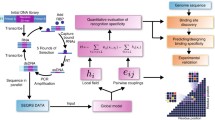Abstract
Selection for affinity for free histidine yields a single RNA aptamer, which was isolated 54 times independently. This RNA is highly specific for the side chain and binds protonated L-histidine with 102−103-fold stereoselectivity and a dissociation constant (K D ) of 8–54 μM in different isolates. These histidine-binding RNAs have a common internal loop–hairpin loop structure, based on a conserved RAAGUGGGKKN0–36 AUGUN0–2AGKAACAG sequence. Notably, the repetitively isolated sequence contains two histidine anticodons, both implicated by conservation and chemical data in amino acid affinity. This site is probably the simplest structure that can meet our histidine affinity selection, which strengthens experimental support for a “stereochemical” origin of the genetic code.







Similar content being viewed by others
References
Burgstaller P, Kochoyan M, Famulok M, (1995) Structural probing and damage selection of citrulline- and arginine-specific RNA aptamers identify base positions required for binding Nucelic Acids Research 23:4769–4776
Cadwell R.C., Joyce GF, (1994) Mutagenic PCR PCR Meth Appl 2:S136–S140
Ciesiolka J, Illangasekare M, Majerfeld I, Nickles T, Welch M, Yarus M, Zinnen S, (1996) Affinity selection-amplification from randomized ribooligonucleotide pools Methods Enzymol 267:315–335
Connell GJ, Yarus M, (1994) RNAs with dual specificity and dual RNAs with similar specificity Science 264:1137–1141
Connell GJ, Illangsekare M, Yarus M, (1993) Three small riboligonucleotides with specific arginine sites Biochemistry 32:5497–5502
Famulok M, (1994) Molecular recgnition of amino acids by RNA-aptamers: An L-citrulline binding RNA motif and its evolution into an L-arginine binder J Am Chem Soc 116: 1698–1706
Famulok M, Szostak JW, (1992) Stereospecific recognition of tryptophan agarose by in vitro selected RNA J Am Chem Soc 114:3990–3991
Geige A, Burgstaller P, von der Eltz H, Roeder A, Famulok M, (1996) RNA aptamers that bind L-arginine with sub-micromolar dissociation constants and high enantioselectivity Nucleic Acids Res 24:1029–1036
Illangasekare M, Yarus M, (2002) Phenylalanine-binaing RNAs and genetic code evolution J Mol Evol 54:298–311
Knight R, Yarus M, (2003) Finding specific RNA motifs: Function in a zeptomole world? RNA 9:218–230
Knigh FR, Birmingham A, Yarus M, (2004) BayesFold: Rational 2 degrees folds that combine thermodynamic, covariation, and chemical data for aligned RNA sequences RNA 10:1323–1336
Knight RD, Landweber LF, (1998) Rhyme or reason: RNA-arginine interactions and the genetic code Chem Biol 5 :R215–20
Krol A, Carbon P, (1989) A guide for probing native small nuclear RNA and ribonucleoprotein structure Meth Enzymol 180:212–227
Lozupone C, Changayil S, Majerfeld I, Yarus M, (2003) Selection of the simplest RNA that binds isoleucine RNA. 9:1315–1322
Majerfeld I, Yarus M, (1994) An RNA pocket for an aliphatic hydrophobe Nat Struct Biol 1:287–292
Majerfeld I, Yarus M, (1998) Isoleucine: RNA sites with associated coding sequences. RNA 4:471–478
Mannironi C, Scerch C, Fruscoloni P, Tocchini-Valentini GP, (2000) Molecular recognition of amino acids by RNA aptamers: The evolution into an L-tyrosine binder of a dopamine-binding RNA motif RNA 6:520–527
Morris KN, Jensen KB, Julin CM, Weil M, Gold L, (1998) High affinity ligands from in vitro selection: Complex targets Proc Natl Acad Sci USA 95:2902–2907
Roth A, Breaker RR, (1998) An amino acid as a cofactor for a catalytic polynucleotide Proc Natl Acad Sci USA 95:6027–6031
Wilson DS, Keefe AD, (2000) Random metagenesis by PCR. In: Ausubel FM, Brent R, Kingston RE, Moore DD, Seidman JG, Smith JA, Struhl K (eds) Current protocols in molecular biology. John Wiley and Sons, New York, pp 8.3.1–8.3.9
Woese CR, Dugre DH, Saxinger WC, Dugre SA, (1966) The molecular basis for the genetic code. Proc Natl Acad Sci USA 55:966–974
YangY, Kochoyan M, Burgstaller P, Westhof E, Famulok M, (1996) Structural basis of ligand discrimination by two related RNA aptamers resolved by NMR spectroscopy Science 272:1343–1347
Yarus M, (1988) A specific amino acid binding site composed of RNA Science 240:1751–1758
Yarus M, Christian EL, (1989) Genetic code origins Nature 342:349–350
Yarus M, Knight RD, (2004) The scope of selection. In: Pouplana LR (ed) The genetic code and the origin of life. Landes Bioscence, Georgetown, TX, pp 75–91
Yarus M, Caporaso JG, Knight R (February 11, 2005) Origins of the genetic code: The escaped triplet theory. Annu Res Biochem 74:179–198. DOI: 10.1146/annurev.biochem.74.082803.13119
Acknowledgments
We thank members or our laboratory for comments on the manuscript. Preparation of this manuscript was supported by NIH Grant GM 48080 and NASA Center for Astrobiology Grant NCC2-1052.
Author information
Authors and Affiliations
Corresponding author
Additional information
[Reviewing Editor: Niles Lehman]
Rights and permissions
About this article
Cite this article
Majerfeld, I., Puthenvedu, D. & Yarus, M. RNA Affinity for Molecular L-Histidine; Genetic Code Origins. J Mol Evol 61, 226–235 (2005). https://doi.org/10.1007/s00239-004-0360-9
Received:
Accepted:
Published:
Issue Date:
DOI: https://doi.org/10.1007/s00239-004-0360-9




